Historical crime writing is a varied type within the crime genre, and seems to be growing. From stories based on true crimes to conspiracies, the importance of getting the history right is crucial. Not just right, but the history has to be believable. A good historical crime book needs to effortlessly create the background to the story without overwhelming it with detail. Sometimes the writer has to battle with clichéd portrayals or assumptions of the past, skating over the fine detail to get the big picture across. Each writer has to decide where to draw the line between a history textbook and a modern story. Sometimes the story just has to come first.
In no particular order, these are my current favorites of historical crime books, most set in Great Britain, and most taking place at least 100 years ago. They have all drawn that line between history and story slightly differently, and all have fascinated and sometimes haunted me.
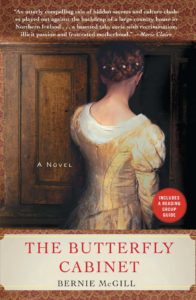
Bernie McGill, The Butterfly Cabinet
In 1890s Northern Ireland, wealthy Harriet Ormond starts a prison sentence for killing her child, four year old Charlotte, hanged in a cupboard. The story is told through Harriet’s prison diaries and the story of the servant who was present, Maddie McGlade, seventy years after the death. Beautifully written, the character of Harriet seems cold, distant, and like the jurors, we don’t sympathize when she struggles with prison life. But the story is far more complicated than it seems. The brutality of the crime is matched by the coolness of the mother, who is revealed through her prison diaries, a lonely and dominated child who grew into a difficult woman. The Butterfly Cabinet is based on a true story, the death of Mary Helen Montagu aged three, who died at the hands of her mother in 1892 in Portstewart. Annie Montagu received twelve months for murder. A very different time is evoked through the book, where the silent Charlotte hangs over both narratives. So much historical fiction is centered on capital cities, but Bernie McGill conjures a different world of Northern Ireland, with its divisions and class system. It evokes the cold of the prison cell, the cold at the heart of the main character, who can’t accept love even from her own children.
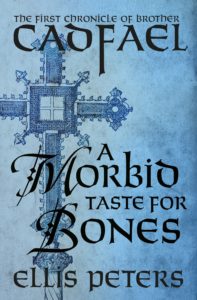
Ellis Peters, A Morbid Taste for Bones
Still one of my favorite series of historical crime, Brother Cadfael is an ex-soldier turned to living as a monk in 1137, one of the most turbulent and lawless periods of English history. Ellis Peters brought this distant period to life, and the world was so wonderfully researched it was convincing. Many of the characters were based on real people, and she wove Cadfael’s story in so deftly into it he seemed real too. To enhance the spiritual reputation of the abbey, Prior Robert decides to take the bones of a Welsh saint from her tomb back to the abbey. There are objections from local landowner Rhisiart, who is found with an arrow in his chest. Cadfael has to find the murderer and supervise the removal of the saint’s bones, which he does with common sense and understanding. For fans of historical fiction, Ellis Peters takes us back into an alien world before law and order, before government, when slaves had only just crept up the social ladder to become serfs, and lords ruled like kings.
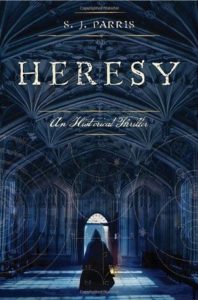
S.J. Parris, Heresy
S. J. Parris creates a world that is vivid and fast changing, in a time when the whole of England was seething with plots to defend or overthrow the queen, her government or the church. Exploring the murky world of Elizabethan spies and treason, apostate monk Giordano Bruno is fleeing the Inquisition and employed to uncover a Catholic plot at the centre of Oxford’s academic world. Based on a real character, Bruno has a modern—and heretical—understanding of the world and people’s motivations. He’s a great character, mingling with the powerful at court despite thirteen years as a monk he has great understanding of emotion. The book is filled with devious, intertwined plots, horrible murders and plenty of action. The historical world is created deftly and isn’t overwhelmed by details, and the characters tell the story.
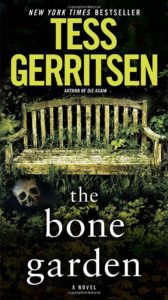
The Bone Garden
In the present day, Julia Hamill discovers a female skull in her garden, from the distant past but clearly the victim of a murder. In 1830, Norris Marshall becomes a ‘resurrectionist’ to help pay his medical school fees, stumbling onto a series of murders. While you can enjoy this simply as a crime puzzle to solve, it takes the reader back to a time before modern medicine when doctors went from an autopsy to women giving birth, spreading fatal infections without knowing it. Julia uncovers the mystery of the skull and the killings through letters and interviews with descendants of the 1830 principals. It’s a book that is terrifying and gruesome in places, but had me hoping and hoping that the only witness to the murders—and probably the next victim – isn’t the battered skull in Julia’s garden. It’s an interesting time to recreate, most books written about the nineteenth century focus on the industrial advancements like railways, growth in prosperity and technology. But 1830 was a dark time, where people fought for survival in a new world. Tess Gerritsen summons the darkness, the indifference and the constant danger in a terrifying read.
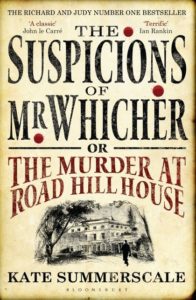
Kate Summerscale, The Suspicions of Mr Whicher or The Murder at Road Hill House
Another wonderful Victorian mystery that is based on a true story; in this case, the murder of a small boy in his own home. The scandalous story was followed by Victorians in the paper, various low born people like the nursemaid being suspected. Detective Whicher comes into the house with an objective viewpoint, battling with the snobbery and entitledness of the grieving family. They protect the person who starts to stand out as a suspect: sixteen year old Constance, the child’s stepsister. It becomes a battle between the classes, between emotion and reason, and the police and the press. Kate Summerscale rounds out all the characters in the book, never letting us forget the three year old victim, his throat cut, in the servants’ privy. Somehow she blends facts with fiction so seamlessly the reader takes it all as one story. Kate Summerscale finds the invisible division between the working class detective and the middle class family and shows us every misdirection, every suspicion. Although I knew the case, I was turned around, puzzled and fascinated by the story.
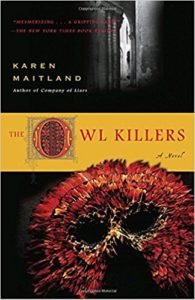
Karen Maitland, The Owl Killers
As a historical writer I stay safely in the modern era, a time from the Tudors onwards where there was some law and order, where parliament ruled with the monarch. But in 1321 most people grubbed a living from a little land rented to them by their all-powerful lord or the church. But no-one had power over the pagan traditions of centuries. In 1321, a group set up a religious community run by women, for women. These “beguines” did not have to take the veil formally, nor marry and they could keep their dowries. They could leave when they wanted, they could even marry. Into one of these beguinages comes a high born girl, the witness to a gruesome murder and raped by what she thinks is a demon. The villagers start to blame the beguinage for crops failing and cattle dying. Fear builds until violence is just a word or deed away. The story roams across many narrators, as the church fails to keep order and the Owl Masters take over. This is the book that made me want to write historical crime. Karen Maitland created a world so strange I almost wanted to stop on each page and look around and wonder at the filth, the poverty, the lives of these people, at the mercy of nature, ignorance and their corrupt masters.
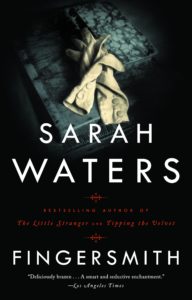
Sarah Waters, Fingersmith
A convoluted tale of lunatic asylums, deception and double crosses, set in Victorian England, Fingersmith portrays the lives of Maud and Sue, each exploited in turn by a man, “the Gentleman.” Through all the horrors of their fractured lives and loyalties, the two women form a tense relationship, which ultimately shapes the whole book. This world is set in the time of Dickens but this is no morality tale. The story is set entirely in the lowest layers of society from servants to the slums to the asylum. The women prey on their victims and each other, and the story feels as stifled and confined as the characters. Sarah Waters paints a picture of a dangerous place and time with dark humor as well as hurt and rage. Despite the melodrama, the characters are believable and their motives are understandable. The book doesn’t wear its historical research on its sleeve, but instead casts literary nods to Dickens, to Edgar Allen Poe and even Laclos’s Les Liaisons Dangereuses. The twists and turns are sudden and surprising, and ultimately satisfying.
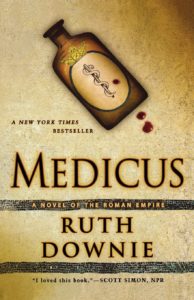
Ruth Downie, Medicus
The first of a series set in Roman Britain, Medicus tells the story of a disillusioned Roman army doctor, Gaius Petreius Ruso, sent to the barbarian north of the empire: Britannia. In this rebellious island, he is called to examine the body of a slave girl. Ruso realizes an injured slave girl, Tilla, has information and buys her as a cook to tease more information out of her. Ruth Downie meticulously builds the world, not of sunny Roman courtyards and temples but a working regiment in an occupied country. It never feels like a history lecture, the world is shown deftly through the everyday life and actions of the characters. Ruso is irritable, stressed and overworked, but his curiosity draws him into the mystery. Ruso and Tilla are an irresistible pairing, the intelligent British girl with the cynical doctor go on to investigate crimes in a whole series of books. The characters are very recognizable to a modern reader, and the whole book has humor running through it. I can especially recommend reading the first page, where a list of characters foretells the story cleverly. The historical background is authoritative and brilliantly researched. Despite his frustrations, Ruso has a satisfying arc through to a new partnership and the rest of the series.
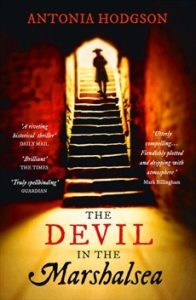
Antonia Hodgson, The Devil in the Marshalsea
For four terrifying days in 1727, Tom Hawkins is imprisoned for a debt of ten pounds. Antonia Hodgson crafts the living hell of the Marshalsea’s worse punishments. Tom fights to be released if he can solve a murder committed inside the prison. The actual prison is recreated from diaries and documents from the period. Antonia Hodgson draws a picture of the squalor, the danger and the impending removal to the ‘Common Side’, the quarters of the poor, a death sentence for a parson’s son. Well researched, the book shows a society devastated by financial collapse, gambling, exploitation and amorality. Tom, the central character, is our eyes and ears and the prison is as strange and terrifying a place for him as it seems to us. Debtors had no rights until they paid off their debts, and would be expected to provide rent and food for their involuntary lodgings. Destined for the church, Tom has fallen into gambling and sin, and the prison offers a chance for some kind of redemption. If he survives. Almost every character is a rogue, including Tom, yet many are likeable, making a living as best they can. This is not a cosy, period drama, this is fast and dramatic with great characters.
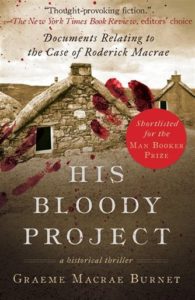
Graeme Macrae Burnet, His Bloody Project
A tale told by the seventeen year old accused murderer, Roderick Macrae, from prison in Inverness, Scotland who is suspected of three violent deaths. The story, set in 1869, is of oppressed Scottish crofters scratching a living on the edge of the western coast in Culduie. The whole book is told as a “found history,” with witness statements from all parts of the examination (each with their prejudices and lies) including those of Roddy’s father, the prison doctor and his own journal. The question of culpability is explored, with ideas of madness and “moral imbecility” put forward to explain his terrible actions. This book reminded me of Alias Grace by Margaret Attwood, only peripherally about the victims and the crime, and more about the society’s response to the horror and a fascination with the perpetrator. There is a real sense of the cultured people of Inverness reveling in the goings-on in Culduie. Roderick becomes a spectacle, a specimen shaped by his environment. It is fiction, but it is written so convincingly as a family history that you wonder all the way through the book if it’s real. It asks questions about the effects of brutality and emotional neglect throughout, as well as exploring the murders themselves. The last third of the book answers some questions but leaves the reader with more. An intoxicating read.

















